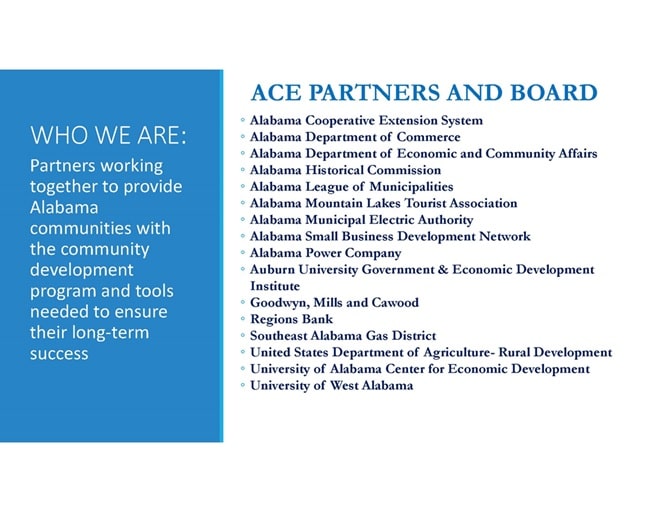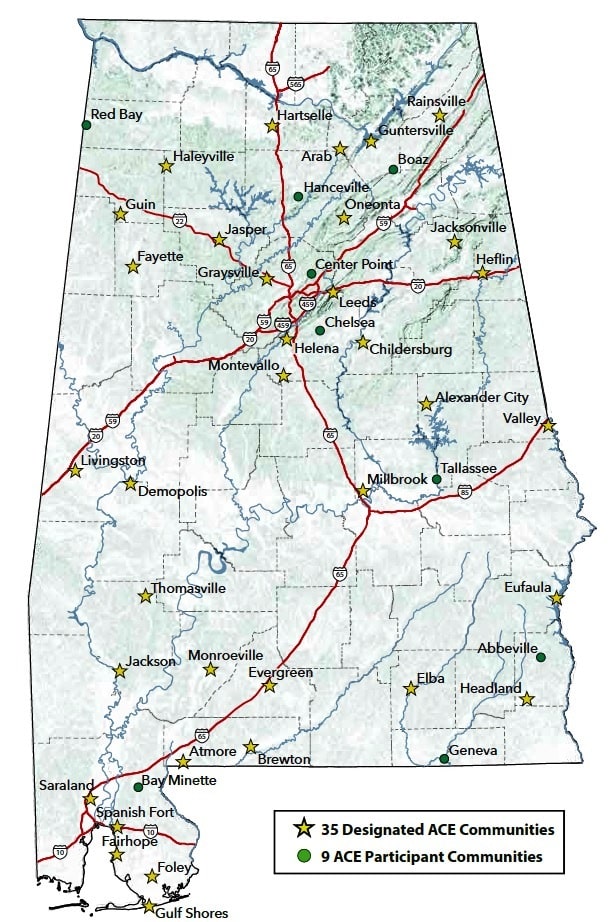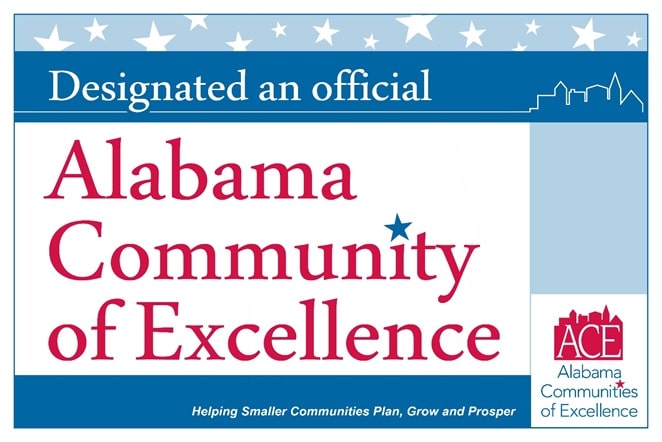What does it take to be an Alabama Community of Excellence?

Thirty-five cities have successfully completed the comprehensive three-phase process to become an Alabama Community of Excellence. (file)
Sidney Hoover is executive director of the Alabama Communities of Excellence.
A growing number of towns are earning the Alabama Communities of Excellence (ACE) seal of approval and seeing transformative results from the process.
What is ACE and what does it take to earn the designation?
Simply put, the statewide initiative helps smaller Alabama cities with populations of 2,000 to 18,000 reach their full potential.
Using the collective expertise of its partner and associate organizations, ACE offers technical assistance and tools combined with a systematic approach to enable communities to achieve long-term economic success. ACE partners and associate organizations range from state agencies and associations to banks, utilities, universities, nonprofits and others that share a common interest in fostering this unique community development program.

The ACE program understands that every community is unique, and recognizes that each town has different assets, values, concerns and priorities. Participating communities develop a vision based on their own sensibilities and assets.
Alabama NewsCenter illustrated these differences when the site profiled several ACE cities in 2017. Featured communities were:
Those articles explored these towns’ attractions and achievements, and illustrated how ACE’s asset-based approach to development helped each of these communities leverage their strengths and characteristics to achieve their goals and build on their successes. Additional ACE-designated communities will be featured this year on Alabama NewsCenter.
With that in mind, here is more background on what ACE is and what ACE does.
Founded in 2002, the ACE program started with five pilot communities: Brewton, Demopolis, Guin, Haleyville and Guntersville. The ACE program has grown to 44 Alabama cities spread across 31 of the state’s 67 counties.
 Thirty-five cities have successfully completed the comprehensive three-phase process to earn their designation as an Alabama Community of Excellence. Nine more communities are working toward designation, including Geneva, which is expected to graduate this year and be recognized at the Alabama League of Municipalities annual convention in May.
Thirty-five cities have successfully completed the comprehensive three-phase process to earn their designation as an Alabama Community of Excellence. Nine more communities are working toward designation, including Geneva, which is expected to graduate this year and be recognized at the Alabama League of Municipalities annual convention in May.
 Communities participating in the ACE program are expected to meet ideals spanning a range of topics in the “Definition of an ACE Community,” which sets forth targets for community development that span leadership, planning, economic development and quality of life.
Communities participating in the ACE program are expected to meet ideals spanning a range of topics in the “Definition of an ACE Community,” which sets forth targets for community development that span leadership, planning, economic development and quality of life.
The “Definition of an ACE Community” provides an objective standard to measure achievements. Beyond the main topics, it covers a range of economic development activities, including industrial, commercial and retail development, as well as tourism and existing business retention.
Quality of life guidelines in the ACE definition recognize not only the community’s aesthetic and cultural features, but also the importance of education, workforce training, healthcare and public safety.
Although it would be unrealistic to expect communities to fully attain the entire scope of these comprehensive and challenging objectives, the “Definition of an ACE Community” establishes goals to strive toward.
At the core, ACE principles call for community stakeholders across a broad demographic spectrum to be involved. This goes hand in hand with the development of local leaders and leadership capacity, and an emphasis on developing and implementing short-term and long-term plans to further realize the town’s vision. Successful communities embrace these core values and incorporate them into their community development activities and strategies.
Broad-based community participation and engagement is a fundamental characteristic of the ACE process. ACE encourages communities to aim for a diversity of gender, age, ethnicity and socioeconomic status that reflects the demographics of the community. Having a diverse spectrum of people involved in developing and implementing plans has tremendous value to the community. It brings a variety of perspectives and skills to the process, helps grow the leadership base, and builds broad-based grass-roots support for development initiatives.
Strong public support and civic engagement help provide the resources and manpower required to realize the objectives. Another advantage of building broad-based community support for development initiatives is sustainability during the inevitable changes in elected leadership. Pragmatically, when a community “owns” an initiative, the incoming mayor/council is less likely to abandon or derail the project as being the brainchild of a former administration.
Having an active leadership development program is a key success measure for ACE communities. A strong leadership program offers opportunities for both adult and youth learning. ACE encourages an interactive, participatory class format that engages the participants – not just lectures and presentations.
Diversity is important and leadership class members should represent a broad cross-section of the community’s demographics. Expanding the leadership pool has rewards, but often these new leaders lack experience. In addition to the more traditional approach of educating participants about community history, programs and issues, leadership programs need to help develop skills such as facilitation/meeting management, communication/public speaking and consensus building. ACE suggests that the curriculum invest about 50 percent of the course time on developing leadership skills, and the remaining 50 percent on community information and awareness. ACE offers communities resources to assist with curriculum design for local leadership programs.
The ACE program emphasizes the value of planning – both short-term strategic and long-term comprehensive planning. A strong strategic plan creates a shared vision, defines priorities and establishes communitywide goals and strategies.
The comprehensive plan serves as a guide for the community to develop its infrastructure and other community facilities, promotes application of design principles, and maximizes physical features and assets for growth and development.
A strategic plan is relatively short term, usually covering a three- to five-year period, and is updated at least annually. In contrast, a comprehensive plan is long term, typically 10 to 20 years, and is updated every five years. The strategic and comprehensive plans should work together to help guide the community achieve its vision.
Since plans that sit on a shelf and are not implemented have little value, it is important to detail the various actions the community commits to take to achieve the stated goals. Action plans should include specifics about who is responsible for each action item, and establish a timeline for their accomplishment.

In summary, an ACE community uses civic engagement to create a shared vision, develop goals and strategies to achieve that vision, establish planning objectives, and involve citizens in the implementation. One of the many technical services that ACE provides its communities is access to skilled strategic planning facilitators.
Communities are selected for the ACE program using a competitive application process. A city that successfully completes the three-phase ACE approach to community development to become designated as an Alabama Community of Excellence has the skills, knowledge and confidence to achieve long-term success. An ACE community has a broad-based civic vision, and is working from a specific implementation plan to access resources to achieve its goals. Participating in ACE demonstrates a community commitment to planning and growth, and helps build a committed and knowledgeable leadership base.





